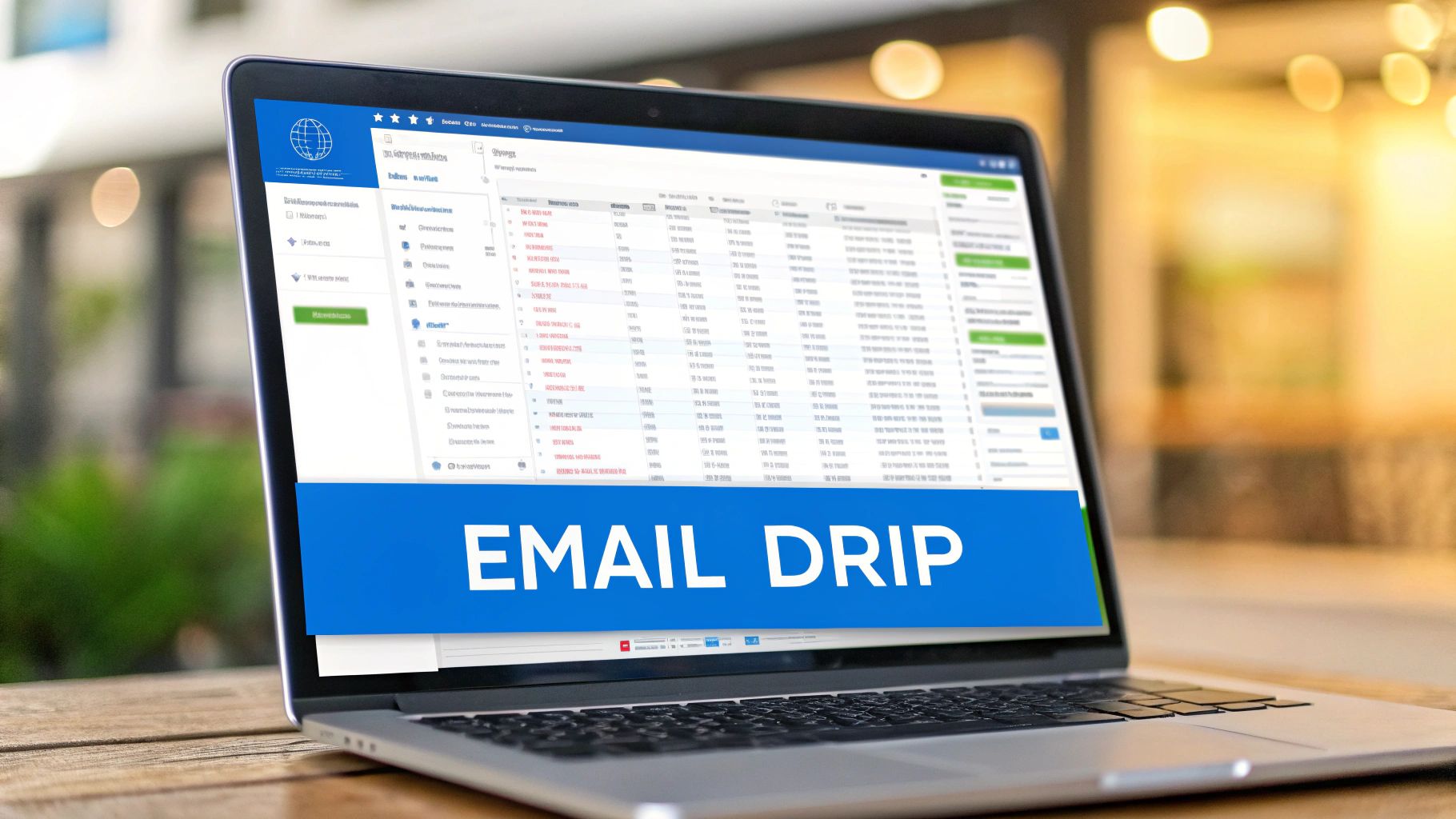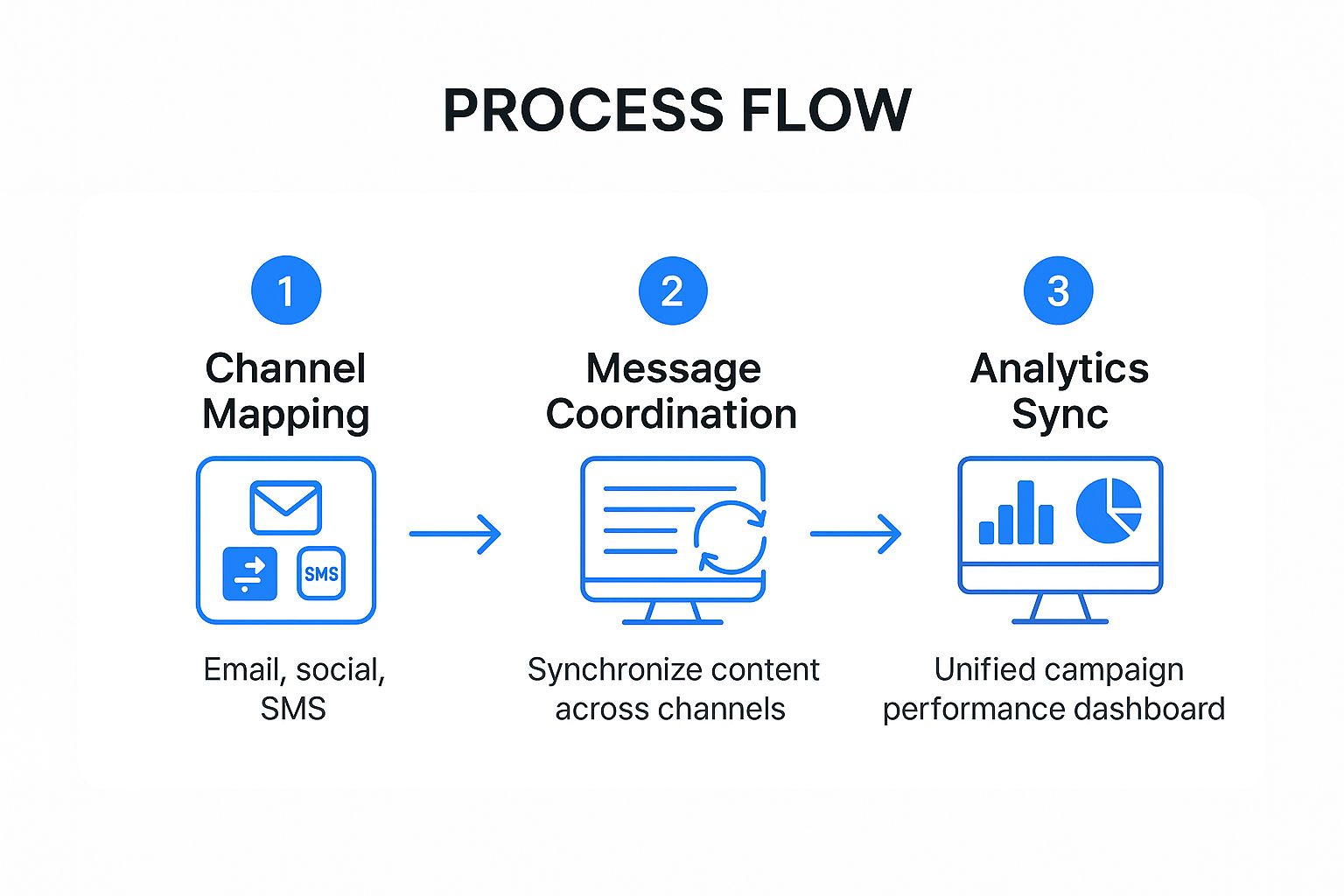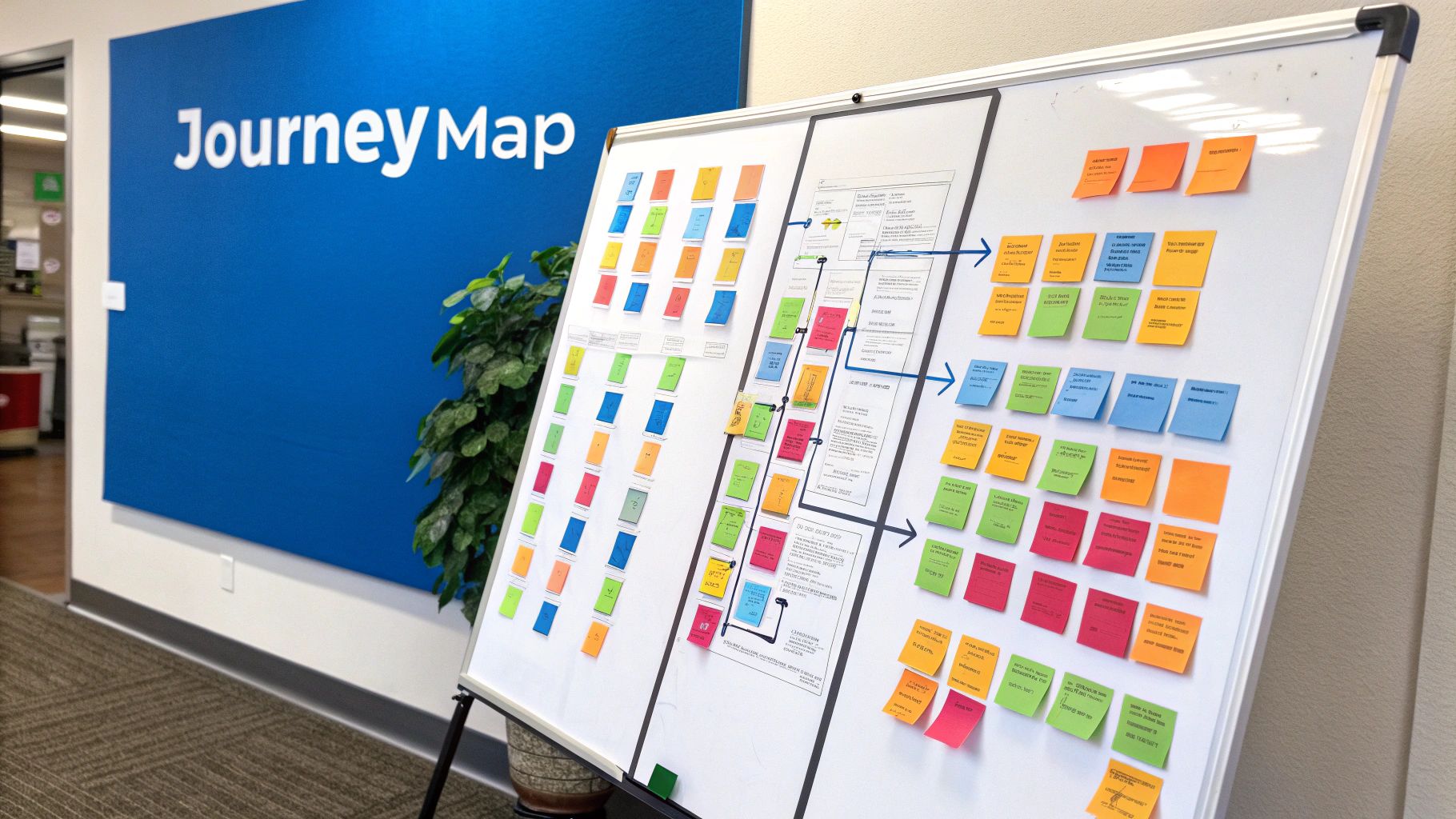In today's fast-paced market, staying ahead means working smarter, not just harder. Marketing automation has moved beyond a simple convenience to become a critical engine for growth, enabling businesses to deliver personalized experiences at scale. However, simply owning the tools isn't enough. True success lies in mastering the strategy behind them. This guide cuts through the noise to deliver proven, actionable marketing automation best practices that turn potential into profit.
We'll move beyond the basics to explore sophisticated techniques, from intelligent lead scoring and multi-channel campaign orchestration to data-driven A/B testing and dynamic personalization. These are the strategies that transform generic outreach into highly effective, revenue-generating machines. For a deeper exploration of advanced marketing automation best practices, including valuable tips and strategies, consider reading this comprehensive guide.
Whether you're a solo creator refining your email sequences or a small business owner looking to streamline your social media efforts with platforms like PostOnce, these principles will help you build a more efficient and impactful marketing ecosystem. You will learn how to implement systems that nurture leads, engage customers, and drive measurable results without manual intervention. Let's dive into the practices that will unlock your growth potential.
1. Lead Scoring and Segmentation
Effective marketing automation isn’t about blasting the same message to everyone; it’s about delivering the right message to the right person at the right time. This is where a systematic approach to lead scoring and segmentation becomes one of the most crucial marketing automation best practices. Lead scoring is the process of assigning numerical values to prospects based on their behaviors, demographics, and engagement levels to rank their readiness to buy.

This method allows you to prioritize high-value leads for your sales team, ensuring they focus their efforts on prospects most likely to convert. When combined with segmentation, which groups your audience based on shared characteristics, you can create highly targeted and personalized campaigns that resonate deeply. For example, B2B companies using Salesforce Pardot have achieved up to 67% higher conversion rates by implementing these strategies.
### How to Implement Lead Scoring and Segmentation
Getting started doesn't have to be overly complex. The key is to build a foundational model and refine it over time with real data.
- Start Simple: Begin with a basic point system. Assign higher scores for high-intent actions like requesting a demo (+25 points) or visiting your pricing page (+15 points). Award lower scores for top-of-funnel activities like a blog post view (+2 points).
- Define Your Segments: Group leads based on your scoring thresholds. For instance, leads with 0-49 points are "cold," 50-99 are "warm," and 100+ are "sales-qualified leads" (SQLs) ready for sales outreach.
- Use Negative Scoring: Discourage poor-fit leads from reaching sales. Subtract points for actions like unsubscribing from emails (-10 points) or visiting your careers page when they aren't a job seeker (-5 points).
- Align with Sales: Regularly review your scoring criteria and thresholds with your sales team. Their feedback is invaluable for ensuring the leads passed to them are genuinely qualified and ready for a conversation. This alignment is a cornerstone of successful marketing automation.
2. Drip Email Campaign Automation
Beyond one-off email blasts, a truly effective strategy involves nurturing leads over time with automated, sequenced messages. Drip email campaign automation is one of the most powerful marketing automation best practices because it allows you to build relationships and guide prospects through the buyer's journey. This approach delivers a series of pre-written emails at specific intervals or based on user actions, ensuring your brand stays top-of-mind with relevant, timely content.

The goal is to move a contact from initial awareness to a state of purchase-readiness without manual intervention. By delivering valuable information systematically, you establish trust and authority. For instance, Dropbox famously used referral drip sequences to help generate 3.9 billion referrals, demonstrating the immense power of automated, behavior-driven communication. Platforms like ActiveCampaign and ConvertKit have popularized this method, making it accessible to businesses of all sizes.
### How to Implement Drip Email Campaign Automation
Building a successful drip campaign requires a strategic map of your customer’s journey, not just a random sequence of emails. The key is to provide value at every step.
- Map Sequences to the Buyer's Journey: Create distinct drip campaigns for different stages. A welcome series for new subscribers should be different from a re-engagement campaign for inactive users or an onboarding sequence for new customers.
- Use Behavioral Triggers: While time-based sends are useful, trigger emails based on user actions for maximum impact. Send a follow-up email when someone clicks a link, visits a specific webpage, or abandons their shopping cart.
- Include a Clear Call-to-Action (CTA): Every email in your sequence should have a purpose and guide the user to the next step. Whether it's reading a blog post, downloading a guide, or booking a demo, make the CTA obvious and compelling.
- Test and Optimize: Don't set and forget your campaigns. Continuously test different email frequencies, subject lines, send times, and content. A/B testing is essential for refining your approach and maximizing engagement rates over time.
3. Progressive Profiling
Long, intimidating forms are a major cause of conversion friction. Progressive profiling is a marketing automation best practice that elegantly solves this problem by gathering customer data gradually over multiple interactions instead of demanding everything at once. This strategy uses smart forms to reveal new fields to returning visitors, building a comprehensive customer profile over time without overwhelming them.
This incremental approach significantly reduces form abandonment and improves the user experience. By asking for information in context, you increase the likelihood of getting accurate, valuable data. For example, Unbounce customers have seen conversion rates increase by as much as 25% by implementing progressive forms. Similarly, this technique helped LinkedIn boost its form completion rates by 45%, demonstrating its power in both B2B and B2C contexts.
### How to Implement Progressive Profiling
The goal is to make data collection feel like a natural conversation, not an interrogation. Start small and build on what you learn with each interaction.
- Start with Essentials: Your initial form should only ask for the bare minimum, such as an email address and first name. For subsequent interactions, you can ask for company size, job title, or specific interests.
- Use Conditional Logic: Configure your forms to show new fields based on previous answers or the content the user is accessing. If they download a B2B case study, ask for their job title next.
- Implement Data Enrichment: Use tools to automatically supplement the data you collect. Services can pull in company information, location, and social profiles using just an email address, filling gaps without burdening the user.
- Show Progress: For multi-step forms, use a progress bar. This visual cue manages expectations and encourages users to complete the process, as it shows them how close they are to finishing.
- Audit Your Data: Regularly clean and review your database to ensure accuracy. This ongoing maintenance is vital for effective segmentation and personalization down the line.
4. Multi-Channel Campaign Orchestration
Today’s customer journey is not linear; it spans multiple channels from social media and email to SMS and push notifications. A critical marketing automation best practice is to orchestrate your campaigns across these touchpoints to create a single, cohesive customer experience. This approach ensures your messaging remains consistent while leveraging the unique strengths of each channel to guide users seamlessly toward conversion.
Multi-channel orchestration moves beyond running siloed campaigns. Instead, it coordinates every interaction, ensuring a message seen on Instagram is reinforced by a follow-up email and supported by a timely SMS alert. Companies that master this see significant returns; for instance, Sephora’s integrated multi-channel strategy led to an 80% higher customer lifetime value by creating a unified and engaging brand experience.
The following infographic outlines the foundational process flow for building a coordinated multi-channel campaign.

This process highlights the importance of mapping channels, synchronizing content, and unifying analytics to achieve true orchestration.
### How to Implement Multi-Channel Campaign Orchestration
A successful multi-channel strategy hinges on meticulous planning and centralized management. The goal is to make every touchpoint feel like part of the same conversation.
- Map Customer Journeys: Before automating, visually map the typical paths customers take. Identify key touchpoints across all channels, from initial discovery on social media to post-purchase follow-up via email.
- Centralize Your Content Calendar: Use a single calendar to plan and schedule content for email, social media, blogs, and SMS. This prevents message collisions and ensures thematic consistency.
- Implement Frequency Capping: Prevent overwhelming your audience by setting limits on how often a single user can receive messages across all channels within a specific timeframe.
- Test Channel Combinations: Experiment to find the most effective sequences. Does a social media ad followed by an email perform better than an email followed by an SMS? Use A/B testing to optimize your channel mix. To dive deeper into specific channel strategies, explore these social media automation tools.
5. Behavioral Trigger Automation
One of the most powerful marketing automation best practices is responding to customer actions in real time. Behavioral trigger automation is a responsive marketing approach that initiates specific actions based on user behaviors like website visits, email opens, or purchase history. Instead of broadcasting messages on a set schedule, this practice creates timely, relevant interactions that capitalize on customer intent the moment it's expressed.
This real-time responsiveness makes your marketing feel less like a one-way announcement and more like a two-way conversation. It shows customers you are listening and providing value precisely when they need it. For instance, Amazon's famous abandoned cart emails, triggered when a user leaves items in their cart, are reported to recover a significant portion of otherwise lost sales. Similarly, platforms like Intercom use behavioral triggers to send in-app messages to users who have just used a new feature, boosting adoption and engagement.
### How to Implement Behavioral Trigger Automation
Implementing effective triggers is about identifying high-impact moments in the customer journey and creating an automated, helpful response.
- Start with High-Impact Triggers: Don't try to automate everything at once. Focus on the most valuable actions first, such as abandoned carts, first-time purchases (for a welcome sequence), or viewing a specific product multiple times.
- Set Appropriate Delays: Timing is everything. An abandoned cart email sent one hour after the event often performs better than one sent immediately, as it gives the user time without seeming intrusive. Test different delays to find the sweet spot for your audience.
- Use Behavior Scoring: Not all behaviors are equal. Assign scores to different actions to determine trigger sensitivity. For example, a user who visits your pricing page three times in a week is showing higher intent than someone who reads one blog post, warranting a more direct follow-up.
- Implement Fallback Sequences: For more complex trigger chains, plan for what happens if a user doesn't take the next desired action. A fallback sequence can re-engage them with alternative content or offers, ensuring no lead goes cold.
6. A/B Testing and Optimization
Relying on assumptions is one of the quickest ways to stall your marketing efforts. A systematic approach to A/B testing, where you compare two versions of a single variable to see which performs better, is one of the most powerful marketing automation best practices for driving continuous improvement. This practice moves you from "I think this will work" to "I know this works" by using hard data to guide your decisions.
This method of continuous experimentation allows you to optimize every element of your campaigns, from email subject lines and send times to call-to-action (CTA) button colors. For instance, the Obama campaign famously raised an additional $75 million in donations through rigorous A/B testing of their website and email messaging. By isolating and testing one variable at a time, you can systematically enhance performance and maximize your return on investment.
### How to Implement A/B Testing and Optimization
Effective A/B testing is a disciplined process, not a random guess. Building a consistent testing framework is key to unlocking meaningful, long-term growth.
- Test One Element at a Time: To get clear, unambiguous results, only change one variable per test. For example, test two different subject lines while keeping the email body and send time identical. This isolates the impact of the subject line on your open rates.
- Focus on High-Impact Elements: Prioritize tests that have the greatest potential to move the needle. Start with elements that directly influence core metrics, such as email subject lines (affecting open rates), CTAs (affecting click-through rates), and landing page headlines (affecting conversion rates).
- Ensure Statistical Significance: Don't declare a winner too early. Run your test long enough to collect sufficient data and ensure the results are statistically significant, meaning they aren't due to random chance. Most marketing automation platforms have built-in calculators for this.
- Document and Learn: Keep a detailed log of every test you run, including your hypothesis, the variable tested, the results, and what you learned. This repository of insights will prevent you from repeating mistakes and help you build on past successes. You can track these improvements alongside your other key performance indicators; learn more about essential content marketing metrics on postonce.to.
7. Customer Journey Mapping
Truly effective automation anticipates customer needs rather than just reacting to their actions. This is why customer journey mapping is one of the most strategic marketing automation best practices you can adopt. It involves creating a visual representation of every interaction and touchpoint a customer has with your brand, from initial awareness all the way through to becoming a loyal advocate. This map reveals critical moments, pain points, and opportunities for improvement in the user experience.

By understanding the entire lifecycle, you can identify precisely where automation can have the most impact, whether it's by delivering supportive content, triggering a helpful follow-up, or resolving a common issue before it escalates. For example, Maersk, the shipping giant, used journey mapping to understand customer frustrations, leading to process improvements that reduced customer service calls by an impressive 20%. This proactive approach shifts your automation from a simple tool to a core part of your customer experience strategy.
### How to Implement Customer Journey Mapping
Building a useful journey map requires a blend of data-driven insights and customer empathy. The goal is to see your business through your customer's eyes.
- Start with Key Personas: Don't try to map everyone at once. Focus on your most important customer persona first to create a detailed and actionable map. You can expand to other segments later.
- Use Real Customer Data: Base your map on actual data from analytics, customer surveys, support tickets, and sales team feedback, not internal assumptions. This ensures your map reflects reality.
- Map Emotional States: For each stage of the journey, document the customer's likely emotions, goals, and pain points. Are they confused, excited, or frustrated? This context is key for designing empathetic automation.
- Involve Multiple Departments: Your journey map should not be a marketing-only project. Involve sales, customer service, and even product development to get a holistic view and ensure organizational alignment on improving the customer experience.
- Identify Automation Opportunities: With the complete journey mapped out, pinpoint specific touchpoints where an automated email, message, or task could resolve a pain point or enhance a positive moment. This is where your map turns into a powerful action plan.
8. Data Integration and Clean Database Management
Your marketing automation engine is only as powerful as the fuel it runs on, and that fuel is your data. A foundational marketing automation best practice is maintaining a clean, accurate, and unified customer database across all your systems. This involves regular data cleansing, deduplication, standardization, and seamless integration to ensure your automation workflows function flawlessly and deliver truly personalized experiences.
Dirty or siloed data leads to broken workflows, embarrassing personalization mistakes, and wasted resources. By prioritizing data hygiene, you create a single source of truth that empowers every marketing action. For example, HubSpot users who consistently use data cleansing tools have reported reducing their email bounce rates by as much as 60%, drastically improving campaign performance.
### How to Implement Data Integration and Clean Database Management
Building a robust data management strategy is an ongoing process, not a one-time fix. Here are the key steps to get started and maintain a healthy database.
- Implement Validation Rules: Prevent bad data from entering your system in the first place. Set up validation rules in your forms to ensure information like phone numbers, emails, and postal codes are entered in a standardized format.
- Audit and Clean Regularly: Schedule routine audits of your database to find and fix inaccuracies, merge duplicate contacts, and remove outdated information. Ensuring the accuracy and deliverability of your email lists is paramount for effective automation. To achieve this, implementing robust email verification best practices is a critical step.
- Use Standardized Naming Conventions: Create and enforce a clear system for naming campaigns, assets, and data fields. This consistency prevents confusion and makes it easier to track performance and manage integrations across different platforms, including social media channels. You can learn more about how to manage your marketing channels effectively to keep your data aligned.
- Train Your Team: Ensure everyone who interacts with your database understands the importance of data quality and is trained on proper data entry protocols. This human element is often the first line of defense against data decay.
Top 8 Marketing Automation Best Practices Comparison
| Item | Implementation Complexity 🔄 | Resource Requirements ⚡ | Expected Outcomes 📊 | Ideal Use Cases 💡 | Key Advantages ⭐ |
|---|---|---|---|---|---|
| Lead Scoring and Segmentation | High – requires data analysis & multi-channel setup | Moderate to High – data and tools needed | 30-50% conversion increase | Prioritizing leads; personalized marketing | Improves alignment; optimizes resource use |
| Drip Email Campaign Automation | Moderate – timing & content strategy critical | Moderate – automation platform & content | 119% higher email engagement | Nurturing leads at scale | Scalable nurturing; measurable ROI |
| Progressive Profiling | High – sophisticated tracking, CRM integration | Moderate to High – form and database management | 50-70% reduction in form abandonment | Gradual data collection; content gating | Better UX; builds detailed profiles |
| Multi-Channel Campaign Orchestration | Very High – complex integration & coordination | High – content creation & technical integration | 250% campaign effectiveness boost | Cross-channel consistent messaging | Brand consistency; maximizes engagement |
| Behavioral Trigger Automation | High – advanced tracking and trigger setup | Moderate to High – tracking infrastructure | 50-80% conversion uplift | Real-time personalized messaging | Timely, relevant interactions |
| A/B Testing and Optimization | Moderate – test design and analysis required | Moderate – traffic and testing tools | 20-40% performance improvement | Continuous campaign optimization | Data-driven decisions; maximizes ROI |
| Customer Journey Mapping | High – extensive research and multi-team input | Moderate to High – data and collaboration | 15-20% increased customer retention | Identifying touchpoints & automation gaps | Experience consistency; cross-team insight |
| Data Integration and Clean Database Management | High – ongoing maintenance and system setup | High – technical and resource investment | 35-60% improved deliverability and efficiency | Ensuring data accuracy and compliance | Reduces errors; enhances personalization |
From Strategy to Execution: Your Next Steps in Automation
Navigating the landscape of marketing automation can feel complex, but the path to mastery is paved with clear, strategic steps. We have explored the essential pillars of a successful program, moving from foundational elements like lead scoring and clean data management to sophisticated strategies such as multi-channel campaign orchestration and behavioral trigger automation. Each practice represents a crucial component in building an efficient, responsive, and highly effective marketing engine.
The core theme weaving through these best practices is the shift from broad, impersonal broadcasting to precise, human-centric communication. It is not merely about sending automated emails; it is about delivering the right message to the right person on the right channel at the exact moment they need it. This is the true power of automation.
Synthesizing Your Strategy
The most impactful takeaway is that these practices are interconnected. Your customer journey map informs the logic for your drip campaigns and behavioral triggers. Progressive profiling enriches the data you use for lead scoring and segmentation, which in turn allows for hyper-targeted personalization. And underpinning it all is a commitment to A/B testing and data integration, ensuring your efforts are continuously optimized and built on a foundation of clean, reliable information.
Embracing these marketing automation best practices is not about flipping a switch and expecting instant results. It is a commitment to a cycle of learning, testing, and refining.
Key Insight: True automation excellence is not about removing the human touch. It is about using technology to deliver a more personal, relevant, and timely human touch at scale.
Your Actionable Roadmap Forward
To avoid feeling overwhelmed, approach implementation incrementally. Do not try to launch a multi-channel, behaviorally triggered, progressively profiled masterpiece overnight. Instead, identify your single biggest marketing bottleneck and apply one of these principles.
- Identify a Friction Point: Is your lead follow-up slow and inconsistent? Start by building a simple lead nurturing drip campaign.
- Implement and Test: Are your email open rates low? Focus on A/B testing subject lines and send times for one specific campaign segment.
- Analyze and Scale: Does your sales team complain about lead quality? Implement a basic lead scoring model to better qualify prospects before handoff.
By tackling one challenge at a time, you can achieve measurable wins that build momentum. Each successful implementation provides valuable data and insights, making your next initiative even more effective. Mastering these marketing automation best practices will transform your marketing from a series of disjointed tasks into a cohesive, intelligent system that drives growth, builds stronger customer relationships, and frees up your valuable time to focus on strategy and creativity.
Ready to streamline the "multi-channel orchestration" piece of your marketing automation puzzle? PostOnce simplifies your social media workflow by letting you schedule and publish content across all your platforms from a single dashboard. Stop wasting time juggling tabs and start focusing on the high-impact strategies discussed here by visiting PostOnce to begin.